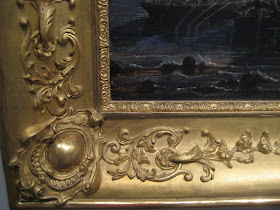A 18th century Chinese chair made of carved ivory
I was highly impressed with my visit to Salem's Peabody Essex Museum it is one of the finest I have been to in America, it is not as well known as major art museums in America but it is the oldest museum in America and well worth a visit if you are in Salem. Salem was one of the first city's in America to have a high number of millionaires due to privateering and shipping during the last 30 years of the 18th century. Because of money in Salem it became a place of great culture, had some of the finest architecture in American at the time and the People of Salem Furnished there mansions with some of the finest furniture and imported decorative arts. We see some of it here thru my photo's.
The museum originally the Peabody Museum of Salem and the Essex Institute, in Salem, Massachusetts is the oldest continuously operating museum in the United States. It was founded in 1799 as the East India Marine Society by a group of Salem-based captains and supercargoes. Members of the Society were required by the society's charter to collect "natural and artificial curiosities" from beyond the Cape of Good Hope or Cape Horn. Due to the institution's age, the items they donated to the collections are significant for their rare combination of age and provenance.
The museum holds one of the major collections of Asian art in the US; its total holdings include about 1.3 million pieces, as well as twenty-four historic buildings. In 1992, the Peabody Museum of Salem merged with the Essex Institute (1822) to form the Peabody Essex Museum. In 2003, the Peabody Essex Museum opened a new wing designed by Moshe Safdie, more than doubling the gallery space to 250,000 square feet (23,000 m²); this allowed the display of many items from its extensive holdings, which had previously been unknown to the public due to lack of capability to show them.
The museum owns 24 historic structures and gardens. Some are shown in the gallery below. The full set of buildings are: Daniel Bray House, Gilbert Chadwick House, Cotting-Smith Assembly House, Crowninshield-Bentley House, John Tucker Daland House, Derby-Beebe Summer House, East India Marine Hall, Gardner-Pingree House and Gardner-Pingree Carriage House, Lye-Tapley Shoe Shop, Dodge Wing of the Peabody Essex Museum, Asian Export Art Wing of the Peabody Essex Museum, Peirce-Nichols House, Samuel Pickman House, Plummer Hall, Quaker Meeting House, L. H. Rogers Building, Ropes Mansion, Andrew Safford House, Summer School Building, Vilate Young (Kinsman) House, and John Ward House.
Chinese export porcelain
Chinese export portrait. Rich Americans in the late 18th Early 19th century displayed exotic export portraits like this in there parlors to show culture
Detail of painted fabric Chinese export portrait.
Between the sixteenth and the nineteenth centuries the Chinese catered to the almost insatiable European demand for porcelain. Made specifically for the western world with distinctive forms and decoration tailored to this market, the "designs and styles [of Chinese export porcelain] were not what the Chinese would have created for themselves," according to Carl Crossman of Northeast Auctions and author of The China Trade (1972) and The Decorative Arts of the China Trade (1991), reserving the finest goods for their native and Imperial markets. Though small amounts filtered into the American colonies, the American market for Chinese export porcelain was finally opened with the 1784 voyage of The Empress of China, financed largely by Philadelphia's Robert Morris.
Chinese export reverse painting made for the American market
Chinese export cornflower decorated platter
Chinese export boars head tureen
Chinese export crab tureen
Chinese export portrait
Chinese export work table
Chinese export ivory fan
Chinese export fan











































This museum seems to be a well kept secret. Thanks for sharing. Richard at www.myoldhistorichouse.blogspot.com
ReplyDeleteI am having an acquisitional attack ... that crab tureen is just perfect! How something with that many bits can survive through the centuries without damage is a miracle. Thanks so much for the visit....the ivory chair reminds me of the Indian baccarat crystal chairs on ebay a while ago... so beautiful.
ReplyDelete